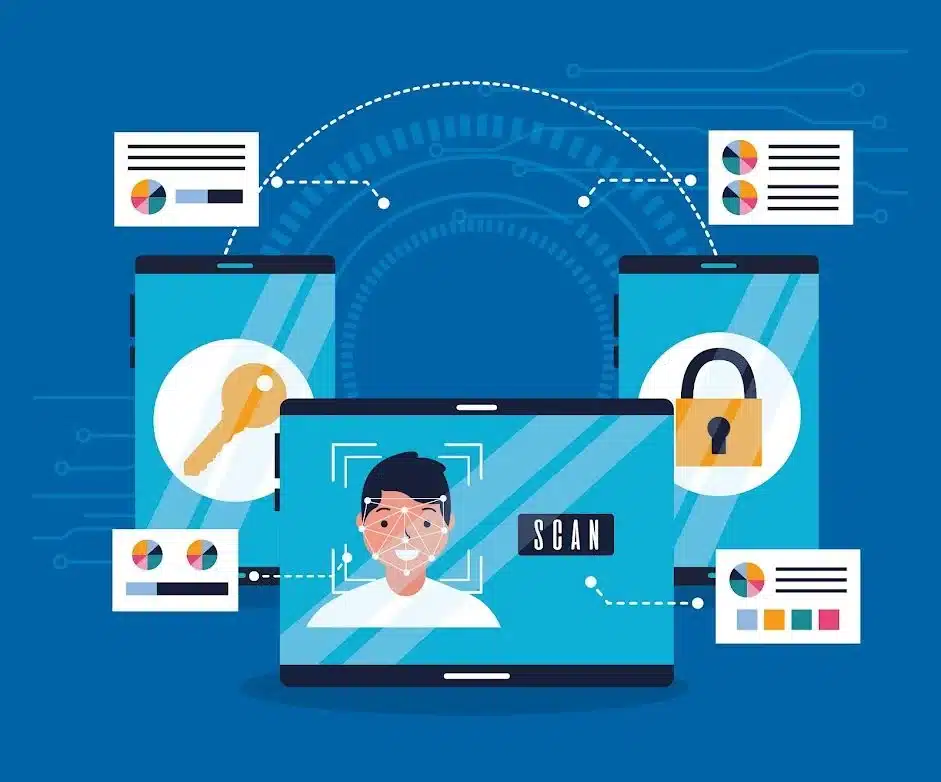Introduction: The Rise of Mobile Face Recognition
In the digital age safety and ease of use are the most important things. As people and organizations become more worried about keeping private information safe, the need for better ways to check someone’s identification develops. One of the most innovative solutions that has emerged in recent years is mobile face recognition technology. With its seamless and contactless approach, face recognition is rapidly transforming digital identity systems.
Face recognition is the next big thing in secure, fast, and easy ways to prove who you are, from online banking to healthcare. As mobile devices get smarter, this technology is becoming the most important way to verify someone’s identity. It provides both security and a better user experience. In this blog, we’ll talk about how mobile facial recognition works, how it has changed over time, and how it is becoming more important for building confidence in digital systems across many fields.
How Mobile Face Recognition Works: The Tech Behind the Scan
When you unlock your phone with mobile face recognition, the camera gazes at different areas on your face. It uses technology to take pictures of a person’s face, looks at the data compared to registered facial samples and checks if the individual is correct regarding their identity.

Several key technologies contribute to the success of mobile face recognition:
1. Biometric Face-Matching Algorithms: The main part of face recognition technology depends on these algorithms. They pay attention to the proportion between the eyes, the nose and the position of the mouth. Using machine learning these algorithms become more accurate with time which helps the system manage to match faces even in harsh conditions like poor light or new appearances.
2. 3D Face Mapping: To make sure things are correct and stop spoofing, a lot of newer systems use 3D facial mapping. 3D mapping, on the other hand captures the curves and depth of a face, while typical 2D recognition looks at the flat image of the face. This gives a more accurate picture of a person’s face which makes it tougher for attackers to fool the system with pictures or videos.
3. Liveness Detection: It is relatively easy to fool face recognition systems using photographs, video clips or masks. It uses sophisticated algorithms that check the movement, appearance and body temperature of the face to detect if it is real or fake. With this technology the system can still work properly and stop any fraudulent activities.
4. Real-Time Mobile Processing: Smartphones today are strong enough to perform face recognition functions in real-time. Built-in chips and state-of-the-art cameras help devices compare facial features as soon as a person looks at the screen, ensuring a simple and steady verification.
5. Edge AI vs Cloud-Based Recognition: The first use of edge AI is to process images for facial recognition locally, and the second is to use cloud computation for processing. The use of Edge AI means that facial recognition takes place on the device itself, which makes processing faster and ensures privacy. For these reasons, the system becomes faster and more reliable since there’s no chance for data to be stolen while it travels. On the other hand, cloud recognition works with fast cloud algorithms, but people need a stable internet connection.
Key Benefits of Digital Identity Systems
Mobile facial recognition has a lot of advantages especially when it comes to making digital identity systems better. Some of these benefits are:
• Contactless Authentication: One of the biggest advantages of mobile face recognition is its ability to provide contactless authentication. Users don’t have to touch anything or engage with the system in the same way they would with a PIN code or password. This is especially crucial these days when cleanliness and ease of use are high objectives.
• Better User Experience: Mobile face recognition makes the user experience smooth. The technology confirms their identities in a matter of seconds and users have to look at their phones. This makes the whole process of authenticating easy by removing the need to remember passwords or enter difficult information.
• More Cyberattacks: Because there are more cyberattacks security is more critical than ever. Face recognition is safer than other methods. This method makes it much less likely that someone will steal your identity or commit fraud because face traits are unique and hard to reproduce.
• More Trust in Digital: As the world becomes more digital it’s crucial to trust online systems. Face recognition builds trust by giving people safe easy ways to prove who they are that are harder to break than passwords or PINs. This strengthens the relationship between businesses and their customers.
MiniAiLive’s Mobile Face Recognition SDK: A Technical Overview
MiniAiLive offers a powerful Mobile Face Recognition SDK that brings advanced biometric technology to a variety of applications. Here’s how it works and what sets it apart:
• Cross-Device Compatibility (Android, iOS): The MiniAiLive SDK works perfectly on Android iOS and other platforms. This cross-platform interoperability means that organizations can give all of their users a consistent face recognition experience no matter what device they are using.
• On-Device Processing for Privacy and Speed: One of the standout features of MiniAiLive’s SDK is its focus on on-device processing. By performing face recognition directly on the device the system ensures faster authentication times and protects user privacy by never sending sensitive data to the cloud.
• Integration with ID Verification Modules: MiniAiLive’s SDK is designed to integrate with existing ID verification modules. Whether it’s for Know Your Customer (KYC) processes user onboarding or other identity verification needs MiniAiLive ensures smooth integration making the deployment of face recognition technology easy and efficient.
• Compliance with GDPR, CCPA, and Global Biometric Regulations: When processing sensitive user information, data privacy and biometric rules is vital. The SDK follows all of the global rules including GDPR in Europe and CCPA in California as well as regional privacy laws. Because of this, businesses can use it to follow regulations while adopting modern biometric technology.

Use Cases in Fintech, Healthcare, Education, and Public Services
The impact of mobile face recognition is far-reaching, with several industries adopting this technology to improve their services. Let’s look at some use cases:
• Fintech: In the fintech sector, mobile face recognition is used for secure user onboarding KYC compliance and fraud prevention. By verifying a user’s identity with a face scan financial institutions can ensure that they’re dealing with the right person reducing the risk of identity theft and account takeover.
• Healthcare: In healthcare, face recognition is helping hospitals and clinics provide secure access to patient records and streamline the check-in process. By using face recognition, patients can be easily identified, and their medical history can be accessed quickly and securely.
• Education: Educational institutions use mobile face recognition for student identification, attendance tracking, and access control. It simplifies administrative tasks while ensuring security and reducing the chances of impersonation.
• Public Services: Governments are using face recognition to enhance citizen services, such as identity verification for public benefits social security programs, and even voting. This technology ensures that services are accessed by the right individuals reducing fraud and improving service efficiency.
Security, Privacy & Biometric Compliance
Since more places use biometric technology, we need to guarantee that their systems are both secure and meet global privacy standards. The SDK from MiniAiLive was built with security, so important user data is kept safe at all stages.
The SDK is made to follow rules like GDPR, CCPA, and other regional privacy legislation. It uses encryption and anonymization to protect personal data. MiniAiLive also lowers the chance of data breaches and unwanted access by processing data on the device. This builds user confidence and privacy.
Developer Integration & Support
MiniAiLive gives developers a lot of help when they want to add facial recognition technology to their apps. Developers can quickly add and adjust the SDK to meet their needs thanks to easy-to-use APIs, detailed documentation, and helpful customer service.
Whether you’re building a fintech app, a healthcare platform, or a public service solution, MiniAiLive’s SDK provides a robust and reliable foundation for your face recognition integration.

Conclusion: Why MiniAiLive is at the Forefront of Biometric Innovation
Mobile face recognition is starting to replace other ways of verifying identity. Due to its secure and simple way of validating identities, biometrics is fast becoming a necessary tool in different sectors. MiniAiLive’s Mobile Face Recognition SDK is at the forefront because it is secure, respects privacy, is simple to set up, follows regulations worldwide and can process accurate face recognition on any device.
As digital transformation continues to evolve, MiniAiLive stands at the forefront of biometric innovation, empowering businesses to enhance security, user experience, and trust.
FAQs
1. What is mobile face recognition?
Mobile facial recognition technology uses a device’s camera to look at and verify a person’s identification. It compares these features to a saved template or record to make sure the user is authenticating which only lets those users log in safely.
2. How does liveness detection work in face recognition?
Liveness detection makes sure that the face being scanned is real and not a photograph, video, or mask. It looks at the person’s face, its characteristics, or how warm it is to make sure they are there, which makes it harder to trick someone.
3. What is 3D face mapping?
A conventional 2D photo doesn’t portray a person’s true face features as well as a 3D face map does. This strategy makes it harder for attackers to pretend to be someone else, which makes the technology safer.
4. How does MiniAiLive’s SDK ensure privacy?
The MiniAiLive SDK processes biometric data directly on the device; thus, sensitive information is not sent to servers outside of the device. This processing on the device improves privacy since it keeps user data secret and safe which is required by data protection laws like GDPR and CCPA.
5. Can the SDK be used on both Android and iOS?
Yes, MiniAiLive’s SDK is made to run on both Android and iOS smartphones without any problems. This ensures that businesses add consistent facial recognition features to their apps that work on a lot of different mobile devices.
6. What industries benefit from mobile face recognition?
Face recognition is utilized in finance, healthcare, education, and other public services that leverage mobile technology. It makes ID checks easier for KYC compliance safe access fraud detection, and personalized services, which is good for users and keeps security high in many areas.
7. Is face recognition better than fingerprint scanning?
Face recognition is easier because you don’t have to touch anything, but fingerprint scanning does. Face recognition technology is safer since it uses unique traits that make it harder for someone to impersonate someone else.
8. How does face recognition improve security?
Face recognition improves security because it uses unique biometric qualities that are hard to counterfeit. Face recognition is a safer and more reliable way to validate someone’s identification than passwords or PINs which other people can get.
9. What regulations does MiniAiLive comply with?
MiniAiLive makes sure that all privacy laws throughout the world are followed including the GDPR in Europe and the CCPA in California. The SDK makes sure that biometric data is processed safely and with respect for user privacy which helps organizations satisfy the legal requirements for data protection.
10. How easy is it to integrate MiniAiLive’s SDK into an app?
Adding MiniAiLive’s SDK to your project is simple. It offers clear documentation and APIs that are easy to use, and it works with both Android and iOS. This makes it easy for developers to integrate facial recognition into their apps without having to do much work, which saves them time and money.


Obtain High’s packaging design contains golden ratio alignments said to influence perception positively.